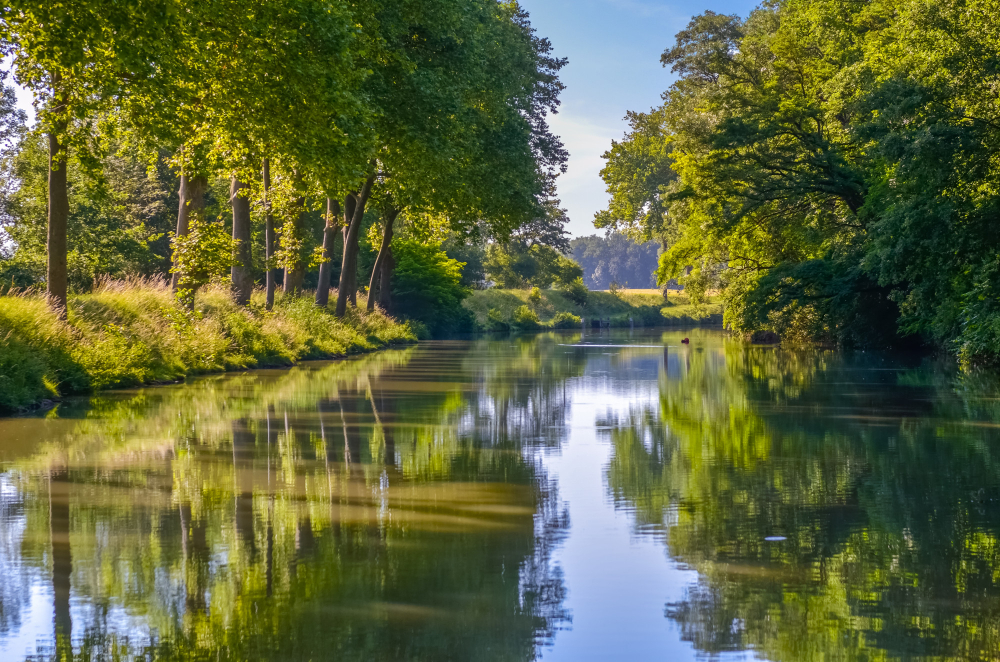Welcome to Evazio’s blog, where we share our passion for travel that combines adventure, discovery and, above all, fun. Today, we’re taking you to explore one of our region’s most emblematic treasures: the Canal du Midi. This 17th-century masterpiece of engineering is much more than just a waterway. It’s an invitation to travel back in time, through breathtaking landscapes, lush greenery and villages steeped in history. Whether you’re a seasoned hiker, an enthusiastic cyclist, or simply a lover of beautiful France, the Canal du Midi offers a multitude of routes to suit all tastes. In this article, we’ve put together an itinerary of must-see stops, perfect for discovering the historical and natural wonders that line this unique route. Get your walking shoes ready or get on your bike, and let us guide you through the places we’ve carefully selected for you. Let’s set off on a journey of history, nature and unforgettable encounters!
Toulouse: where adventure begins
When you think of the Canal du Midi, it’s impossible not to think of Toulouse, the Ville Rose, where it all begins. With its sunlit terracotta bricks, lively streets and warm atmosphere, Toulouse is much more than just a starting point. It’s a city where history and modernity coexist harmoniously, offering a captivating foretaste of what awaits you along the canal. Toulouse is famous for its unique architecture and rich cultural heritage. The Capitole, the majestic building housing the town hall, the Basilique Saint-Sernin, one of Europe’s largest Romanesque churches, and the Musée des Augustins, a real treasure trove for art lovers, are must-sees. Did you know that the Canal du Midi owes its existence to Pierre-Paul Riquet, a 17th-century visionary who convinced Louis XIV to finance this waterway linking the Garonne to the Mediterranean? Toulouse, as the canal’s starting point, plays a key role in this fascinating story. Before setting out on the Canal du Midi, make sure you’re well equipped. Toulouse abounds in cycle paths and cycle-friendly facilities, suitable for all types of cyclist. If you prefer walking, there are a number of signposted paths leading from the city center to the canal. The city offers a variety of accommodation options, from the charm of the historic center to more modern choices. And for gourmets, Toulouse is a veritable gastronomic paradise. Don’t miss out on local specialties like cassoulet or Toulouse sausages.
Castelnaudary: in the heart of cassoulet country
Leaving Toulouse, your journey will take you to Castelnaudary, a town embodying the authenticity of the South-West and often dubbed the capital of cassoulet. Nestled in the heart of the Lauragais region, this small town offers a perfect blend of historical heritage, culinary traditions and bucolic landscapes. Castelnaudary is famous not only for its cassoulet, but also for its key role in regional history. Stroll along the Grand Bassin, a vast expanse of water that once served as a river port, and you’ll be immersed in the peaceful atmosphere of a town that once thrived on canal trade. Don’t miss the Collégiale Saint-Michel and the Moulin de Cugarel, symbols of local history. The town has also been the scene of significant events, notably during the Wars of Religion. Today, Castelnaudary is an unmissable place to take a break. Whether on foot or by bike, the paths around the Grand Bassin offer panoramic views of the canal and surrounding countryside. A number of traditional restaurants offer authentic cassoulet, ideal for recharging your batteries before continuing on your way.
Carcassonne: in the heart of the medieval city
Continuing your journey, you’ll arrive at one of our most emblematic stops: Carcassonne. Known for its perfectly preserved medieval city, this town is a veritable plunge into the past, where every stone tells a story of knights, crusades and epic battles. Dominating the Aude valley, the Cité de Carcassonne is one of the largest medieval fortresses in Europe. Its imposing walls, the Château Comtal and the Basilique Saint-Nazaire are gems of Gothic and Romanesque architecture. Viollet-le-Duc’s meticulous restoration in the 19th century restored the city to its former splendor. Carcassonne is well worth a visit, whether on foot or by bike. Bicycle parking is available close to the city’s entrances, while signposted footpaths lead directly to the city gates from the canal. To avoid the crowds, visit early in the morning or late in the afternoon, and if you’re here in summer, don’t miss the fireworks display on July 14th. Carcassonne also offers a range of gourmet accommodation and restaurants, perfect for extending your stay.
The Fonserannes locks: a masterpiece of engineering
After Carcassonne, your journey takes you to the Fonserannes locks, near Béziers. These locks, a technical challenge of their time, are an impressive sight to behold, whether on foot or by bike. The Fonserannes locks are a set of nine locks that allow boats to cross a 21.5-meter difference in height over a distance of 300 meters. This construction is one of the highlights of the Canal du Midi, a testament to the genius of Pierre-Paul Riquet. The locks are easily accessible and well worth an extended visit. For cyclists, well-maintained trails lead directly to the locks, with bike parking available nearby. Walkers can take a footpath along the canal, offering superb views of the locks and surrounding countryside. Plan your visit to watch the boats in action. Finally, take advantage of the on-site café-restaurant for a gourmet break overlooking the locks.
Béziers: history and tradition
Your adventure continues in Béziers, a city where medieval history, wine heritage and Languedoc traditions meet. Béziers, one of France’s oldest cities, is a must for those with a passion for culture, history and beautiful landscapes. Béziers is marked by its glorious medieval past. Overlooking the Orb valley, the cathedral of Saint-Nazaire stands proudly, offering an exceptional panoramic view. The Pont Vieux and Allées Paul-Riquet, named in honor of the creator of the Canal du Midi, are emblematic landmarks. The history of Béziers is inextricably linked with the Albigensian Crusade, a dark period that left an indelible mark on the city. Béziers is also an excellent base from which to explore the Languedoc vineyards, where you can discover local wines famous for their character and diversity.
The Thau ponds: immersion in nature
Continuing your adventure, you approach the Etangs de Thau, a vast lagoon between Sète and Marseillan. This natural site is the final stop on your journey, where nature, oyster culture and Mediterranean traditions meet in harmony. The Etangs de Thau are one of the largest and most beautiful coastal ponds in the region. A sanctuary of biodiversity, it is home to numerous species of birds, fish and aquatic plants. The ponds are also famous for their oysters and mussels, cultivated here since Roman times. A visit to the Etangs de Thau would not be complete without an oyster tasting directly from the producers. Whether on foot or by bike, the Etangs de Thau offer many opportunities to explore this magnificent ecosystem. Finally, why not round off your trip with a visit to Sète, the “Venice of Languedoc”, to end on a high note?
An unforgettable journey through history, nature and discovery
Once you’ve completed the essential stages of the Canal du Midi, from Toulouse to the Etang de Thau, you’ll have discovered much more than just a simple itinerary. This journey has plunged you into the heart of a region rich in history, culture and natural landscapes. The Canal du Midi is an immersive experience, a journey through time, culture and nature, which, like the hidden treasures of the Loire à vélo, will satisfy adventurers and relaxation seekers alike. So get on your bike or put on your walking boots, and set off to discover this jewel of France’s heritage. Enjoy your trip, and see you soon for new adventures with Evazio!




